Dear Artist,
Psychology Professor Dean Keith Simonton, an expert in genius, says that if you want to up the quality of your work, begin by making more of it. “Empirical research on hundreds, even thousands of artists and scientists,” he writes, “has established that quality is a positive but probabilistic consequence of quantity.” He cites Edison, Mozart, van Gogh and Picasso as reaching for their genius by developing it through prolificacy — 10,000 hours or 10 or so years of a daily torrent of fits and starts is a good beginning to summoning a miracle that could take hold and flourish under a now practiced, steady, prepared and comfortable pair of hands.
In entrepreneurial circles, essayist Herbert Lui encourages innovators, as a route to creative quality, to speed up the cycle of production and feedback. He says that not only is it the quicker path to getting better and better, but that the byproduct can be a more relaxed and less precious approach, which often leads to more inspired work. For Lui, reaching for your own genius begins with setting daily quantity quotas as a means of idea development and discovery. If this feels like a bit of pressure, consider Isaac Asimov’s nearly 500 published works, including his epic guides to the Bible and Shakespeare, his Chronology of the World, his books on the body, photosynthesis, carbon, nitrogen, the moon, the sun, robotics, science fiction, limericks, letters, magazine columns, essays and anthologies, not to mention his 500,000-word National Book Award-nominated The Intelligent Man’s Guide to Science, which he banged out in 8 months — a mere 2000 words a day, plus editing and rewrites.
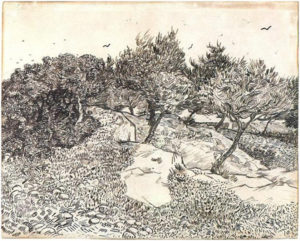
The Rock of Montmajour with Pine Trees, July 1888
Pencil, pen, reed pen, brush and black ink on wove paper
49.1 x 61 cm
by Vincent van Gogh
In his research on skill building, culturist Drake Baer has discovered what he calls, “try fast, fail fast, learn fast,” or the “do-it-a-bunch technique.” It seems this little system lulls the brain into going along with incremental changes that lead to mastery, something it resists if overwhelmed all at once with a big push. If you’re going for greatness, slow and low also doesn’t cut it. Progress, it seems, is in the doing, and doing consistently and quickly.
Dancers, tennis players, coders, pianists, chess players and anyone else in the beginning throws of learning a quantifiable skill will tell you that if you want to get good at something, you need to do it every day. And while it’s easy to fall into “waiting for the muse” when it comes to painting, daily doing absolutely applies to art — you’re simply not going to become a better painter, a better communicator, a better idea generator, a better technician and therefore a better artist unless you apply yourself to it every day. “Periods when a creative makes the most attempts,” says Professor Simonton, “will be when the most hits and misses appear.”
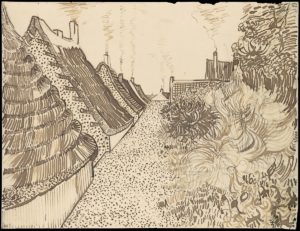
Street in Saintes-Maries-de-la-Mer, ca. July 15, 1888
Reed pen, quill, and ink over chalk on wove paper (backed with wove paper)
24.3 x 31.7 cm
by Vincent van Gogh
Sincerely,
Sara
PS: “All I do is write. I do practically nothing else, except eat, sleep and talk to my wife.” (Isaac Asimov)
Esoterica: “The best way to refine your craft is to create a huge volume of work. Not to create the most perfect piece you can, but to create many pieces of work,” says Ira Glass. In painting, you can comfort yourself in the knowledge that your hits and misses explode privately in the sanctuary of your studio, and you can speed up your process to a comfortable pace and re-stretch, burn or paint over this new volume of non-genius level efforts as needed. Be in the joy and adventure of your own torrent, knowing that your best has its greatest chance of emerging within a system of outright outpouring. “To learn is to broaden, to experience more, to snatch new aspects of life for yourself,” wrote Asimov. “To refuse to learn or to be relieved at not having to learn is to commit a form of suicide; in the long run, a more meaningful type of suicide than the mere ending of physical life…Knowledge is not only power; it is happiness, and being taught is the intellectual analog of being loved.”
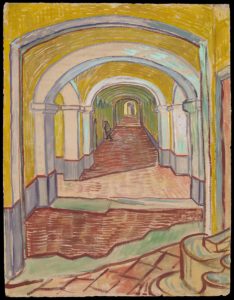
Corridor in the Asylum, 1889
Oil color and essence over black chalk on pink laid Ingres paper
65.1 x 49.1 cm
by Vincent van Gogh
Have you considered a Premium Artist Listing? With each letter, an artist is featured at the bottom of this page. The Premium Artist Listings are a means of connecting artist subscribers through their work. Proceeds from each listing contribute to the production of The Painter’s Keys.
“The chances are that in the course of his lifetime, the major poet will write more bad poems than the minor.” (W.H. Auden)
Featured Artist
Gardens are my enduring inspiration, and getting to the heart of the flower, my passion.

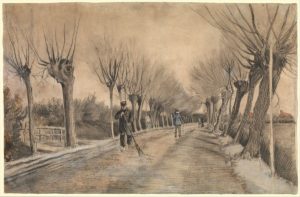
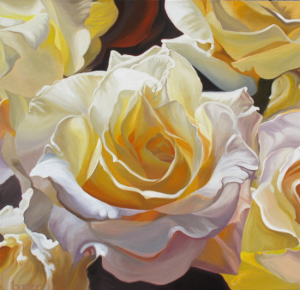



15 Comments
Hello….I do a 14 x 17 inch doodle a day and email the image to a growing list of folks to help them and myself deal with this seemingly awful and endless pandemic. I just completed #286. I have a website 368Art.com if you would like to see some of my work. I’m also 88 years old and have most of my marbles and a steady hand.
Stay safe…Bob Seaman
Bob Seaman: Thank you! Your style is far different from mine, but your work is terrific.
bjb
Me gusta mucho tu obra. Yo también pinto cada día, sólo dos horas, no tengo más tiempo. Tengo 84 años, pero la edad no es un impedimento para nosotros. Felicidades, sigue así muchos años más.
Just looked up your website-fantastic work and such an inspiring attitude.
love your web site and especially like the stone/pebbles constructions. Obviously, practice makes perfect. With the many different examples of subject matter, you have a confident result.
I posit psychology as a probabilistic consequence of academic self-stimulation where “results” can easily be tailored to fit the problem. Such an abused word….Genius….I imagine a genius expert doles out lots of expensive affirmations along with advice….Get to WORK!
This is exactly the message I needed today! Thank you, Sara.
So true. The worst approach in taking time to do our art is to think it’s all so precious that we must walk away thinking it has to be of exceptional quality, if it wasn’t, it was a waste of time. Any person who is successful at what they do, does the work of practice. It may not be fulfilling, but it’s important, and never a waste of time.
The pandemic has allowed me to catch up with the library I’ve accumulated but hadn’t yet read. Since I’m currently reading Lust for Life (novel about Van Gogh’s life), I especially appreciate the drawings you have chosen as illustration, Sara. Thank you. Van Gogh produced more art than most of us ever will, and yet he destroyed a great deal of it as not up to his expectations. Although he needed and would have liked to sell drawings and paintings, he didn’t let his lack of sales keep him from more painting. He had an internal valuation of his work, even faced with constant advice to do something else as a means of earning money.
Quantity does not necessarily generate quality. Mindless creation is exactly that, mindless, This article overlooks the often necessity of looking, thinking and what if-ing.
Thanks, Sara for this encouraging post. I was blessed to go to Hawaii, years ago, to visit my friend and her husband and young children who had moved there. I did a lot of sightseeing of Oahu with my friend. One day, she had an appt., so her husband took me to an area high above Honolulu. I had my camera, and he told me to take a lot of pictures, so that I might get one or two “fantastic” shots. I took his advice, and later, visiting the North Shore, took many pictures of the beach. It was cloudy at the time. Most pictures were nice, but one turned out “stunning”. The upper left side of the photo, a beautiful light was coming out of the clouds. The waves and shore were curving from that point to the lower right corner. It was special. So, I’ve done that with photo taking, ever since. Taking more pictures, is always likely to get you a special few! And as you, Sara and the people you quoted in this letter, say, this can be applied to painting and writing, and more. I remember reading something Andrew Wyeth said, paraphrasing, but he said he didn’t wait to get inspired to do a great painting. Instead, he would go into his studio, every day, and work. And, in the working, is when the inspiration came! Really enjoyed this letter.
Pingback: First 50 Paintings – Weissinger Art
Asimov was prolific and perhaps “great” – but did he truly live?
“Being in the joy of your own torrent” is a wonderful way to say how important it has been for me to try to keep up momentum in my continual quest to keep painting and become a better painter. Forty plus years and still learning and growing.
I paint not to simply create a quantity of work, but ideally to try and keep flowing a continuous stream as best I can. It’s so much better than a start-and-stop existence.
Then it’s just as important to plan, self edit, and question the motivations and paths I have chosen as it is to just produce work. Pausing to think about ones work is a big part of the creative process.
Hello Sarah and Robert,
Thank you for your writing on How to Cultivate Quality, which I found heartening as opposed the previous letter which was disheartening for me. Mostly because becoming to me implies being seen and I still do not have a on line venue to show my art. Focusing on being seen and giving time to figuring out the most appropriate way/site eludes me.
Cultivating quality helped tremendously because I was beginning to feel like I was caught in the throes of OCD. I’d committed myself to make 1000 4X6 collages in a year. The inspiration for this endeavor came from watching a documentary about the painter Roland-Salazar-Rose.
Thank you Karen Taylor for “being in the joy of your own torrent”.
Joy